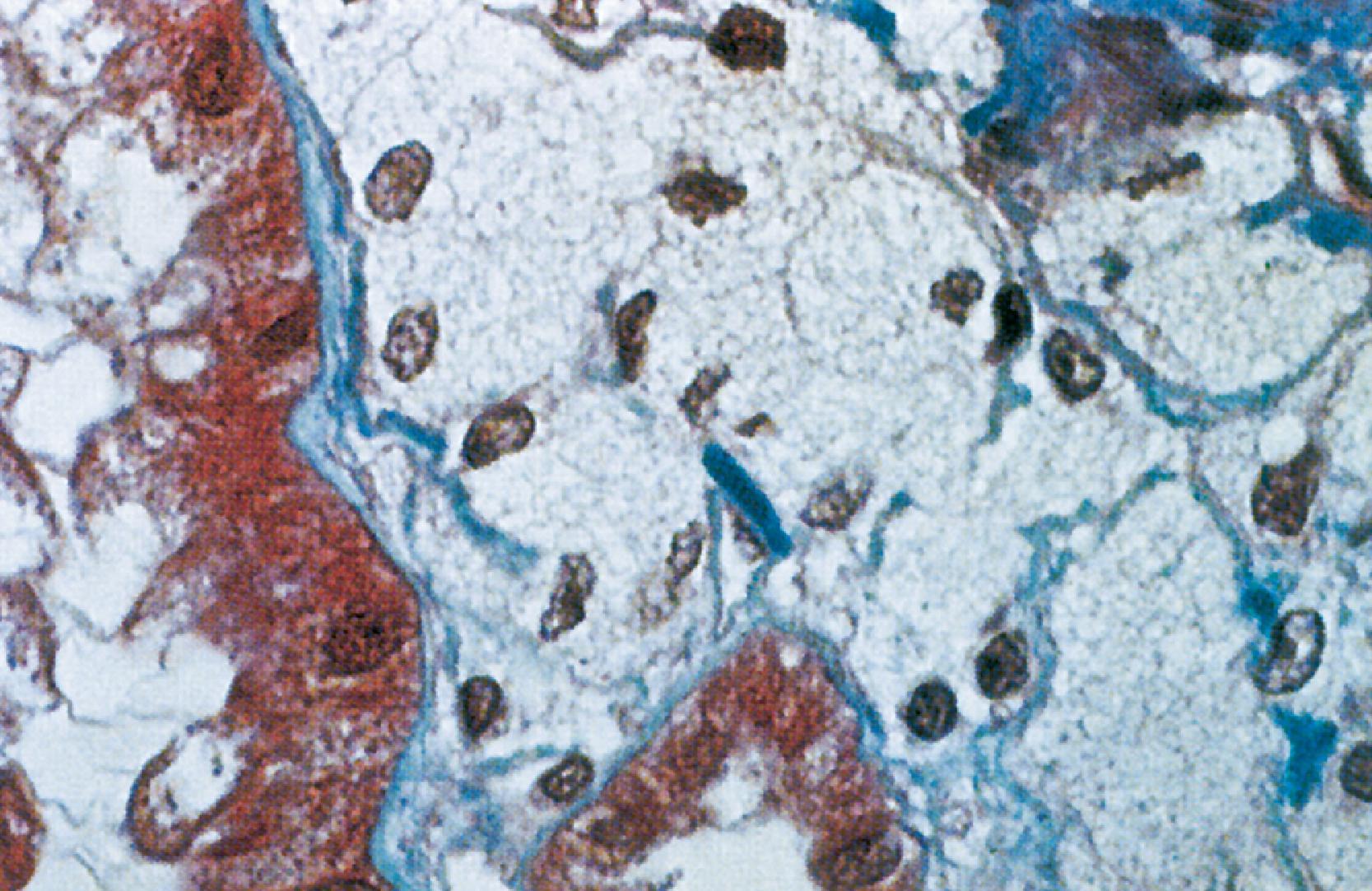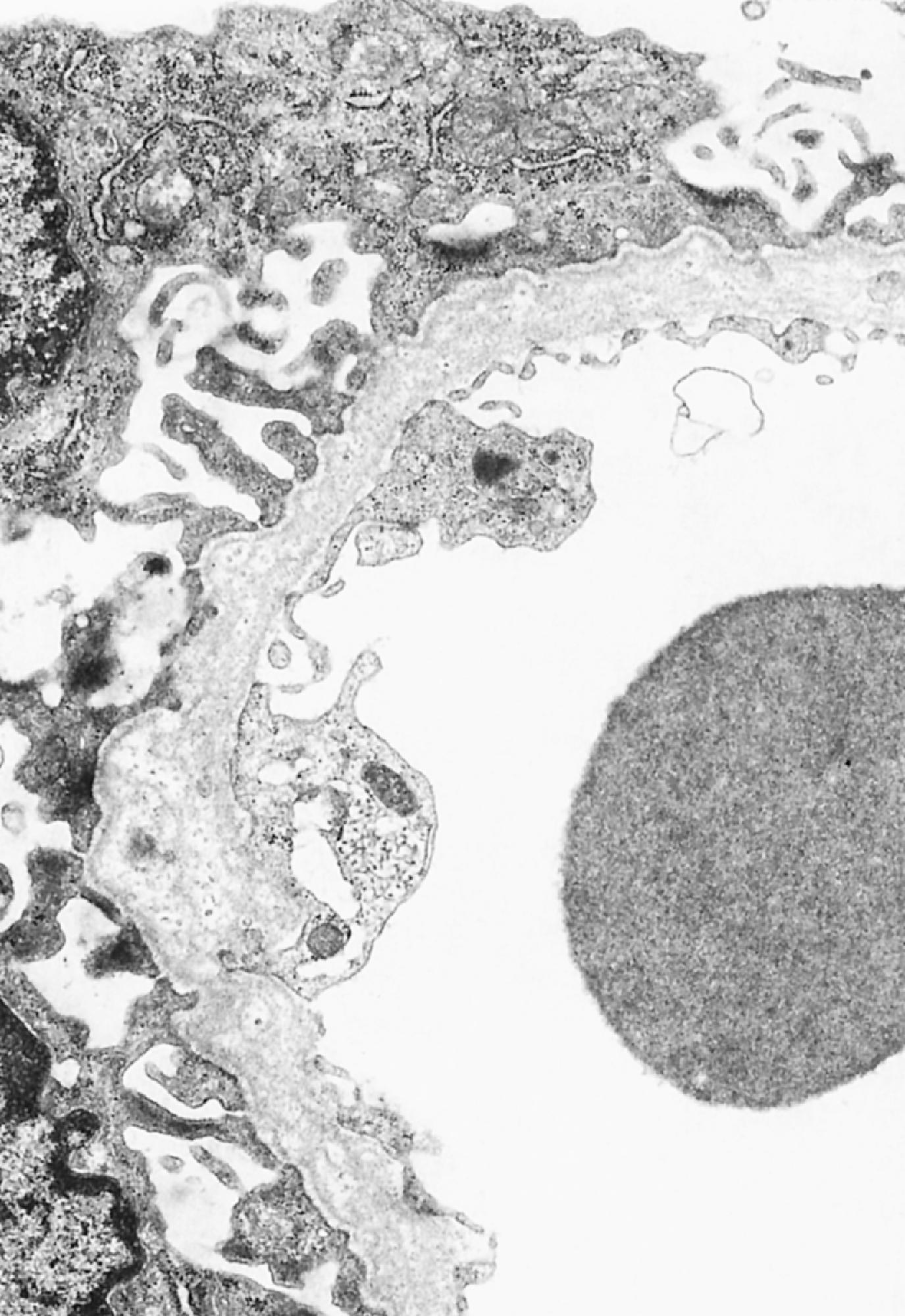Physical Address
304 North Cardinal St.
Dorchester Center, MA 02124
Alport syndrome is a disease of type IV collagen that always affects the kidneys, usually the ears, and often the eyes. Cecil Alport described the association of hereditary hematuric nephritis with hearing loss in a family whose affected male members died in adolescence. Genetic advances have broadened the scope of the condition to include optical defects, late-onset kidney failure, and normal hearing in some families. Approximately 85% of kindreds have X-linked disease, resulting from a mutation of COL4A5, the gene located at Xq22 that codes for the α5 chain of type IV collagen, α5(IV). Autosomal inheritance occurs in perhaps 15% of cases from mutations in COL4A3 or COL4A4.
Kidney failure tends to occur at a broadly similar age in all male members of a family, but this age varies widely among families, with kidney failure in males occurring in childhood or adolescence in some families and in adulthood in others. Forms with early onset of kidney failure in affected males have been called juvenile , while those with kidney failure in middle age are adult type . Some authors use the term hypomorphic to describe mutations that cause very mild or delayed kidney manifestations. Extrarenal manifestations tend to be more prominent in juvenile kindreds. Because boys in juvenile kindreds do not commonly survive to reproduce, these kindreds tend to be small and frequently arise from new mutations, whereas adult-type kindreds are typically much larger without new mutations ( Table 41.1 ).
| Type | Chromosome | Gene | Relative Frequency a |
| X-linked | X | COL4A5 | 85% |
| Juvenile type | 90% of families, 50% of patients | ||
| Adult type | 8% of families, 25% of patients | ||
| Adult type with “normal” hearing | 2% of families, 25% of patients | ||
| Autosomal recessive | 2 | COL4A3, COL4A4 | 15% |
| Autosomal dominant | 2 | COL4A3, COL4A4 | Debated, but likely less than 1% |
a Relative frequencies of the X-linked, autosomal recessive, and autosomal dominant forms are fairly well accepted. The frequencies of “juvenile” (mean age of end-stage kidney disease [ESKD] in males <30 years), “adult” (mean age of ESKD in males >30 years), and adult type with near-normal hearing are rough estimates from the numbers of patients and families known to the University of Utah Alport Study. In the United States, C1564S is a common mutation causing adult-type Alport syndrome, and L1649R is a common mutation causing adult-type Alport syndrome with near-normal hearing.
The open mesh of interlocking type IV collagen molecules that form the framework of the glomerular basement membrane (GBM) is composed of heterotrimers of α chains. In fetal life, these heterotrimers consist of two α1(IV) chains and one α2(IV) chain, but early in postnatal development, production switches to α3(IV), α4(IV), and α5(IV) chains. The primary chemical defect in Alport syndrome involves the α5(IV) chain or, less commonly, the α3(IV) chain, but faulty assembly of the α3,4,5-heterotrimer produces similar pathology in glomerular, aural, and ocular basement membranes, regardless of which α chain is defective. As an illustration of failure of normal heterotrimer formation, most patients whose genetic defect is in the gene coding for the α3(IV) chain lack demonstrable α5(IV) chains in GBMs.
In most kindreds, inheritance of Alport syndrome is X-linked. Causative mutations of COL4A5, the gene coding for α5(IV), are located at Xq22 and appear consistently in many kindreds. These mutations include deletions, point mutations, and splicing errors. There is some correlation between the mutation type and the clinical phenotype: deletions and some splicing errors cause severe kidney disease and early hearing loss. Missense mutations may cause juvenile disease with hearing loss or adult disease with or without hearing loss. Deletions involving the 5′ end of the COL4A5 gene and the 5′ end of the adjacent COL4A6 gene occur consistently in families with Alport syndrome and esophageal and genital leiomyomatosis.
Homozygotes or mixed heterozygotes for mutations of the COL4A3 or COL4A4 genes (chromosome 2) develop autosomal recessive Alport syndrome. Heterozygotes for these mutations account for many cases of benign familial hematuria or familial thin basement membrane disease (TBMD). Cases of digenic inheritance with one mutation in COL4A3 and one in COL4A4 have also been described. As mentioned above for COL4A5 mutations, COL4A3 and COL4A4 mutations are variably pathogenic so that phenotypic variability occurs and some heterozygotes can develop GFR loss or even kidney failure. The frequency of autosomal dominant Alport syndrome is debated: several reports suggest that it may be more common than previously thought.
Patients with autosomal dominant hematuria and kidney failure with thrombocytopenia, giant platelets (Epstein syndrome), and leukocyte inclusions (Fechtner syndrome) have mutations in the MYH9 gene on chromosome 22 (see below). These patients should no longer be considered to have Alport syndrome but rather have MYH9-related disorders.
Male patients with X-linked Alport syndrome and patients with autosomal recessive Alport syndrome frequently lack the α3, α4, and α5 chains of type IV collagen in the GBM, and hemizygous males with X-linked Alport syndrome often lack α5(IV) chains in the epidermal basement membrane (EBM). Monoclonal antibodies specific to the α2 and α5 chains of type IV collagen are commercially available and can be used to assist in the diagnosis of Alport syndrome. The GBM and EBM of normal individuals, as well as those of all Alport patients, react with the α2 antibody, but most male and female patients with autosomal recessive Alport syndrome and most male patients hemizygous for a COL4A5 mutation show no staining of the GBM with the α5 antibody. Males with X-linked disease commonly show no staining of EBM with antibody to α5, whereas females heterozygous for a COL4A5 mutation show interrupted staining of the GBM and EBM, consistent with mosaicism.
After kidney transplants, fewer than 5% of male patients with Alport syndrome develop anti-GBM glomerulonephritis, presumably because they are exposed for the first time to normal collagen chains including a 26-kDa monomer of the α3(IV) chain to which tolerance has never been acquired. Recurrences of anti-GBM glomerulonephritis are usual but not inevitable after repeat transplantation. The serum antibodies to GBM developing after transplantation are heterogeneous; all stain normal GBM, and some stain EBM.
In young children, light microscopy of the kidneys may be normal or near normal. Glomeruli with persistent fetal morphology may be seen. As disease progresses, interstitial and tubular foam cells, which arise for reasons that are unclear, may become prominent ( Fig. 41.1 ), although they are nonspecific and can also be found in many other conditions. Eventually, progressive glomerulosclerosis and interstitial scarring develop. The histology may eventually be that of secondary focal segmental glomerular sclerosis (FSGS), or FSGS may develop without ultrastructural changes of Alport syndrome. Genome-wide searches have shown that an appreciable proportion of adult patients with FSGS have mutations in the COL4A genes despite not presenting with Alport syndrome features. The results of routine immunofluorescence examination for immunoglobulins and complement are negative, and lack of staining for the α5(IV) chain may be informative (see “Immunochemistry”).

The GBM is up to three times its normal thickness, split into several irregular layers, and frequently interspersed with electron-dense granules about 40 nm in diameter ( Fig. 41.2 ). In florid cases of juvenile types of Alport syndrome, the basement membrane lamellae may branch and rejoin in a complex basket-weave pattern. Early in the development of the lesion, thinning of the GBM may predominate or be the only abnormality visible. The abnormalities in boys, adolescent males, and females heterozygous for adult-type Alport syndrome may be unimpressive or indistinguishable from those of TBMD disease (see below).

Become a Clinical Tree membership for Full access and enjoy Unlimited articles
If you are a member. Log in here